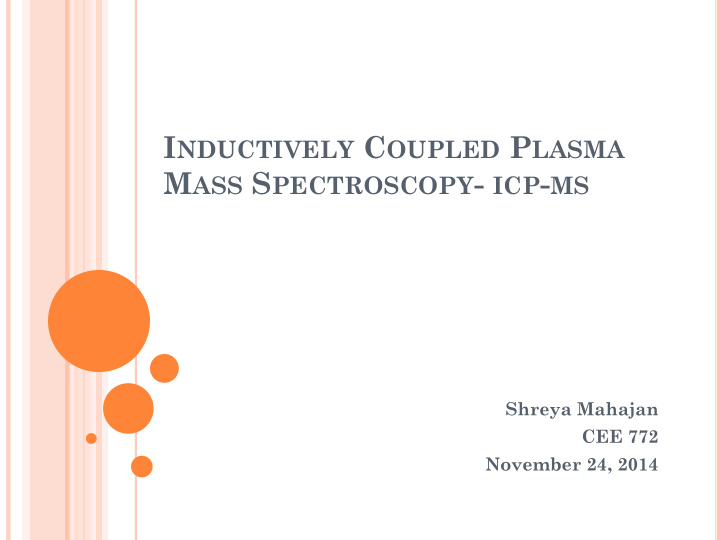



I NDUCTIVELY C OUPLED P LASMA M ASS S PECTROSCOPY - ICP - MS Shreya Mahajan CEE 772 November 24, 2014
E LEMENTS DETECTED BY ICP - MS
An ICP-MS consists of the following components : • Sample introduction system – composed of a nebulizer and spray chamber and provides the means of getting samples into the instrument • ICP torch and RF coil – generates the argon plasma, which serves as the ion source of the ICP-MS • Interface – links the atmospheric pressure ICP ion source to the high vacuum mass spectrometer • Vacuum system – provides high vacuum for ion optics, quadrupole, and detector • Collision/reaction cell – precedes the mass spectrometer and is used to remove interferences that can degrade the detection limits achieved • Ion optics – guides the desired ions into the quadrupole while assuring that neutral species and photons are discarded from the ion beam • Mass spectrometer – acts as a mass filter to sort ions by their mass-to-charge ratio (m/z) • Detector – counts individual ions exiting the quadrupole • Data handling and system controller – controls all aspects of instrument control and data handling to obtain final concentration results Source: www.usgs.gov
M ECHANISM IN THE ICP TORCH Argon gas flows inside the concentric channels of the ICP torch. The RF load coil is connected to a radio-frequency (RF) generator. As power is supplied to the load coil from the generator, oscillating electric and magnetic fields are established at the end of the torch. When a spark is applied to the argon flowing through the ICP torch, electrons are stripped off of the argon atoms, forming argon ions. These ions are caught in the oscillating fields and collide with other argon atoms, forming an argon discharge or plasma
S AMPLE I NTRODUCTION The sample is typically introduced into the ICP plasma as an aerosol, either by aspirating a liquid or dissolved solid sample into a nebulizer or using a laser to directly convert solid samples into an aerosol Once the sample aerosol is introduced into the ICP torch, it is completely dissolved and the elements in the aerosol are converted first into gaseous atoms and then ionized towards the end of the plasma Once the elements in the sample are converted into ions, they are then brought into the mass spectrometer via the interface cones
The quadrupole mass filter is really a sequential filter, with the settings being change for each specific m/e at a time. However, the voltages on the rods can be switched at a very rapid rate The quadrupole mass filter can separate up to 2400 amu per second. This speed is why the quadrupole ICP-MS is often considered to have simultaneous multi-elemental analysis properties The ability to filter ions on their mass-to-charge ratio allows ICP-MS to supply isotopic information, since different isotopes of the same element have different masses
D ETECTION The ions exiting the mass spectrometer strike the active surface of the detector and generate a measurable electronic signal The active surface of the detector, known as a dynode, releases an electron each time an ion strikes it The ion exiting the quadrupole strikes the first dynode which releases electrons and starts the amplification process The ICP-MS accurately determines how much of a specific element is in the material analyzed. In a typical quantitative analysis, the concentration of each element is determined by comparing the counts measured for a selected isotope to an external calibration curve that was generated for that element
W HY USE ICP - MS ? The primary reasons for the growing popularity of ICP-MS can be summarized in a few points: Instrument detection limits are at or below the single part per trillion (ppt) level for much of the periodic table Analytical working range is nine orders of magnitude Productivity is unsurpassed by any other technique Isotopic analysis can be achieved readily Extremely sensitive
R EFERENCES http://crustal.usgs.gov http://www.perkinelmer.com
Recommend
More recommend